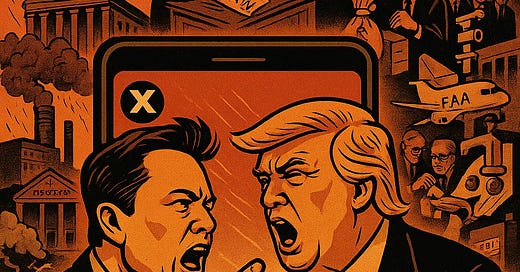Elon vs. Trump: The Battle for Distraction and the Hidden Power Plays
✊ Stay loud. Stay grounded. Stay Independent AF.
In today's hyper-connected media landscape, bombastic headlines often mask the significant structural shifts taking place behind the scenes. While Elon Musk and Donald Trump continue their highly publicized online spat, there are deeper, less-discussed developments that demand our attention. In this post, we dive into the realpolitik and policy maneuvers happening under the radar.
1. The Quiet Rollout of Project 2025
As our screens light up with tweets and viral moments, an audacious plan is unfolding in the background. Heritage Foundation’s Project 2025—a blueprint to reshape the federal government—is being methodically advanced. The plan outlines measures to:
Dismantle civil service protections: Replacing experienced professionals with political loyalists.
Consolidate power in federal agencies: Altering check-and-balance mechanisms traditionally separating the branches.
Rollback crucial rights and protections: Undermining gains in reproductive, LGBTQ+, and environmental matters.
This isn’t a case of isolated policy proposals; it’s a coordinated effort to recalibrate the institutional framework of American governance. Trump allies and conservative power brokers are quietly laying the groundwork for a transformation that could redefine government accountability.
2. Wealth Transfers and Deregulation: Engines of Change
Behind the public drama, significant money movements are occurring. On one side, Elon Musk’s companies continue to secure multimillion-dollar government contracts, particularly in sectors like defense, artificial intelligence, and space exploration. Musk’s combative public persona only enhances his image as an anti-establishment figure—a narrative that serves both his business interests and political allies.
Parallel to this, Trump’s camp is pushing for regulatory overhauls with potentially drastic consequences. Key deregulation efforts include:
Weakening environmental and financial safeguards: Proposals embedded in bipartisan budget bills are designed to loosen restrictions that protect consumers and the planet.
Long-term bans on crucial oversight: For example, discussions around multi-year moratoria on AI regulations could have far-reaching implications for technology governance.
These measures hint at a deliberate push to recalibrate the balance between business freedom and public oversight.
3. Judicial Power Plays
The judiciary remains one of the most potent levers of policy change. Efforts are underway not only to appoint Supreme Court justices but also to fill lower federal courts with ideologically aligned figures. This judicial stacking has two major implications:
Lifetime appointments with lasting impact: Once secured, these positions ensure a conservative tilt in decision-making for decades.
Legal precedents in the making: Key cases regarding presidential immunity, corporate liability, and environmental regulation are being influenced by this new generation of judges.
These moves, though not as flashy as a Twitter battle, are setting the stage for profound changes in American jurisprudence.
4. The Fusion of Corporate Power and State Surveillance
While Musk and Trump dominate headlines with their dramatic exchanges, a more sinister fusion is underway—a merging of state power with corporate data analytics. Companies such as Palantir have been landing expansive contracts that extend their surveillance capabilities into civil sectors including immigration enforcement, social welfare, and more.
Key points include:
Expansion of data-centric government programs: These initiatives promise efficiency but risk stripping away individual privacy and rights.
Unprecedented lack of oversight: As powerful private entities work hand-in-hand with the state, mechanisms for accountability are often intentionally obscured.
This development is not merely technical—it represents an ideological move towards a surveillance state that prioritizes control over transparency.
5. Economic Warning Signs: Recession by Design?
The economic front is fraught with alarming signals. Insiders suggest that orchestrating economic downturns might serve as a strategic tool. By triggering a recession, proponents believe they can:
Reshape public policy: A recession would provide justification for sweeping economic reforms, including slashing social benefits and redirecting funds to preferred priorities.
Capitalize on public disillusionment: Economic distress can create an environment where radical policy shifts seem not only acceptable but necessary.
While Trump’s rhetoric is known for its bombast, the subtle economic maneuvers behind the scenes could have lasting impacts on everyday Americans—driving up costs for food, rent, and insurance, all while public scrutiny remains focused elsewhere.
6. Distraction as a Strategic Narrative
Both Musk and Trump benefit from the power of distraction. Their online conflicts serve several purposes:
Dividing attention: By focusing media and public discourse on their personal disputes, more consequential issues take a backseat.
Controlling narratives: The constant barrage of sensational news allows policymakers and power brokers to operate with reduced scrutiny.
Neutralizing opposition: As critics and political opponents are busy arguing over surface-level issues, more profound challenges to the status quo go unnoticed.
In effect, the online drama becomes a smokescreen—a brilliant, if dangerous, strategy to keep real power struggles hidden from the public eye.
Final Thoughts
As the digital battleground heats up between Elon Musk and Donald Trump, it's critical to step back and ask: What aren’t we being told? The answer lies not in the overt theatrics of social media but in the systematic transformation of our political and economic institutions. The consolidation of power—be it through Project 2025, deregulation, judicial appointments, corporate surveillance, or engineered economic turmoil—is quietly reshaping the country.
For those looking to understand the true contours of these power plays, it’s essential to decode the distraction. Paying attention to who stands to gain behind the scenes can reveal a deeper narrative—one where public spectacle and hidden strategies intertwine.
Stay alert, keep questioning, and remember: sometimes the biggest battles aren’t fought on Twitter, but in the halls of power.
Feel free to subscribe for more insights that cut through the noise to reveal the underlying narratives shaping our world.




